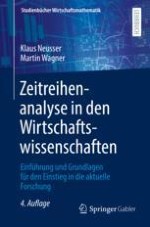2022 | OriginalPaper | Buchkapitel
14. Stationäre strukturelle vektor-autoregressive Modelle
verfasst von : Klaus Neusser, Martin Wagner
Erschienen in: Zeitreihenanalyse in den Wirtschaftswissenschaften
Verlag: Springer Berlin Heidelberg
Aktivieren Sie unsere intelligente Suche, um passende Fachinhalte oder Patente zu finden.
Wählen Sie Textabschnitte aus um mit Künstlicher Intelligenz passenden Patente zu finden. powered by
Markieren Sie Textabschnitte, um KI-gestützt weitere passende Inhalte zu finden. powered by

